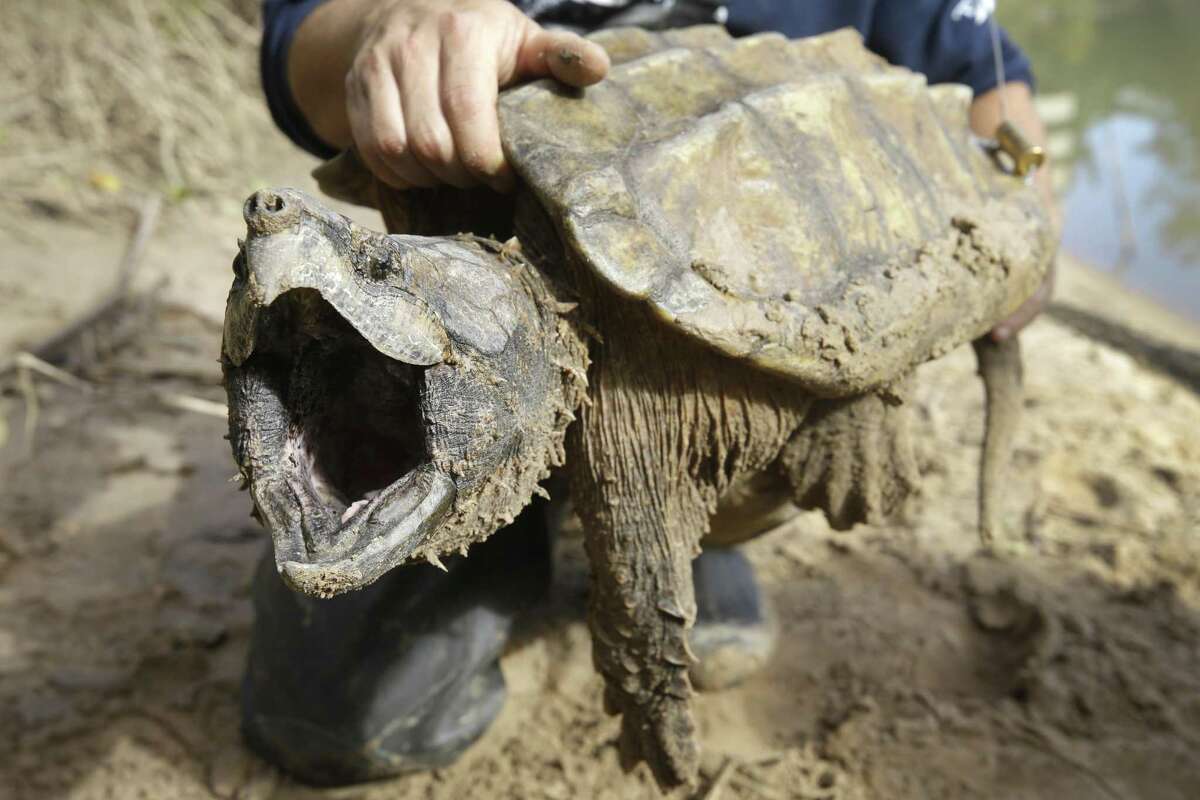Houston Chronicle by Molly Glentzer 11/29/2018
The creature didn’t growl and didn’t need to.
The alligator snapping turtle held menace enough in its massive, gaping jaws, which ended in a sharp beak poised like the fangs of an agitated rattlesnake. Its long, plump claws dug into the sand above thorny, wrinkled skin and a deeply-ridged carapace about the size of a large dinner platter.
Wildlife biologist Eric Munscher has wrangled bigger alligator snappers than the young, 42-pound male he hauled onto land Saturday with help from two assistants. But every one he finds matters, because he’s studying the species in a part of Houston so unlikely it has become the talk of the turtle world.
During the past two years, Munscher and his team have tagged 60 alligator snappers — officially Macrochelys temminckii — in an area no one expected to find them, along a nine-mile stretch of Buffalo Bayou.
Munscher, who leads the Turtle Survival Alliance’s North American Freshwater Turtle Research Group, does not want to reveal exact study locations, to protect what he believes may be the largest population of alligator snapping turtles in Texas, and potentially one of the largest anywhere. And he believes the turtles have survived not in spite of, but because of, their heavily populated, citified surroundings. “They lucked into the whole metro thing,†he said. “It’s a good habitat, surprisingly, with a riparian shelf where females can climb up and lay eggs.â€
Buffalo Bayou’s opaque brown waters have long yielded other scary-looking predators, including prehistoric-looking alligator gars and the occasional, actual gator. And there are plenty of other reasons not to swim there, including possible bacterial pollution.
“Nobody in their right mind would think of Buffalo Bayou as a refuge,†said Jordan Gray, a former Houston zookeeper and a collaborator on the study who now works at the Turtle Survival Alliance’s headquarters in Charleston, S.C. “It’s not this pristine habitat like the Upper Trinity River, but that’s what makes it so cool, to find this gem of a population.â€
Unlike other river turtles, alligator snappers do not float around, and they do not have to sun themselves to raise their body temperature for food digestion. “These guys live in waters that typically don’t get too cold, so their body temperature sits at a decent level,†Munscher explained.
While the females lay their eggs on land, the males live entirely underwater, only poking their snouts above the surface for a few seconds, once an hour or so, for air. And in spite of their fearsome looks, they’re timid; they flee disturbances in the water, making it highly unlikely people in kayaks and canoes will spot them.
Munscher discovered the bayou’s turtles almost by accident through his day job with SWCA Environmental Consultants, while he was surveying wildlife across one of the city’s large parks. He put out turtle traps near the end of the study, not expecting to find anything special, and was astonished to haul up six alligator snappers.
Those first critters ranged from a 3-pound juvenile to a 96-pound male that could be 80 years old, which suggested an active breeding population.
More:
https://www.houstonchronicle.com/news/houston-texas/houston/article/Buffalo-Bayou-an-unlikely-hotbed-for-alligator-13431367.php
That's just a youngster. I saw much larger in Sims Bayou.